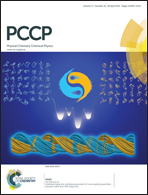In situ strain evolution during a disconnection event in a battery nanoparticle†
Abstract
Lithium ion batteries are the dominant form of energy storage in mobile devices, increasingly employed in transportation, and likely candidates for renewable energy storage and integration into the electrical grid. To fulfil their powerful potential, electrodes with increased capacity, faster charge rates, and longer cycle life must be developed. Understanding the mechanics and chemistry of individual nanoparticles under in situ conditions is a crucial step to improving performance and mitigating damage. Here we reveal three-dimensional strain evolution within a single nanoparticle of a promising high voltage cathode material, LiNi0.5Mn1.5O4, under in situ conditions. The particle becomes disconnected during the second charging cycle. This is attributed to the formation of a cathode electrolyte interphase layer with slow ionic conduction. The three-dimensional strain pattern within the particle is independent of cell voltage after disconnection, indicating that the particle is unable to redistribute lithium within its volume or to its neighbours. Understanding the disconnection process at the single particle level and the equilibrium or non-equilibrium state of nanoparticles is essential to improving performance of current and future electrochemical energy storage systems.


 Please wait while we load your content...
Please wait while we load your content...